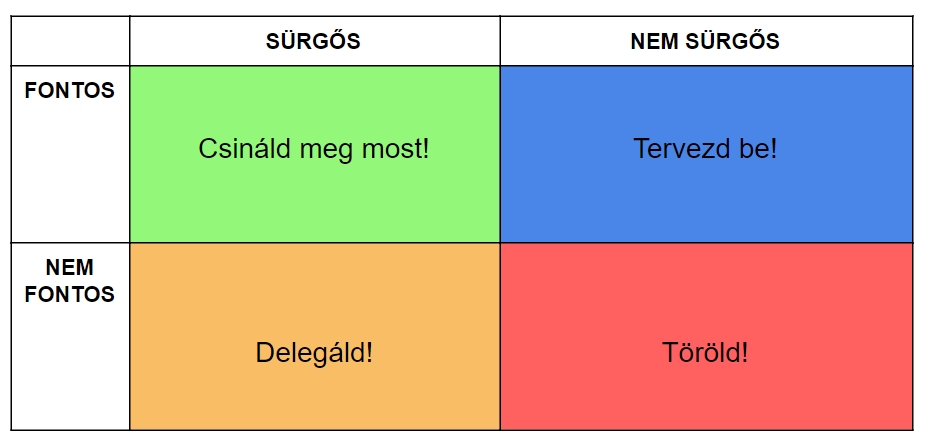
The meaning, concept and use of the Eisenhower matrix
The practicality of the Eisenhower matrix lies precisely in its relative simplicity: anyone can easily use it to prioritise tasks.
For successful and efficient people, money is often not the scarcest resource, but time. Many people find that they have little time to do what they need to do. The Eisenhower matrix is an excellent tool for sorting through seemingly endless tasks and identifying the really important and urgent ones.
What is the Eisenhower matrix?
The Eisenhower matrix is a simple and easy-to-use method for prioritising tasks and managing time more efficiently. The matrix is used to prioritise each task according to its importance and urgency. The Eisenhower matrix gives you an instant overview of the priorities and timing of the tasks you need to complete.

Where does the Eisenhower matrix get its name?
The Eisenhower Matrix is the brainchild of Stephen R. Covey, an internationally renowned organisational development and leadership consultant. The Eisenhower Matrix first appeared in one of his most successful books, the international bestseller The 7 Habits of Highly Effective People.
The matrix itself, however, is named after David D. Eisenhower, General, Chief of Staff and later President of the US Army. Covey named the matrix after Eisenhower because the former president was famous for his efficiency. One of his sayings was "What is important is rarely urgent, and what is urgent is rarely important".
The meaning of the Eisenhower matrix
The Eisenhower matrix is a table of four cells, in which the tasks to be done are grouped into four categories according to their importance and urgency. (It is not by chance that this table is also known colloquially as the "urgent-urgent matrix".)

Once you have entered all the tasks you need to do into one of the four categories above, the previously opaque set of tasks is transformed into a well-structured spreadsheet.
Let's look at what to do with the tasks in each category.
1. Important+urgent: do it now!
At first glance, this is the most pronounced category within the Eisenhower matrix. It includes all tasks that are important and cannot be postponed. It is worth starting the day by doing these and then moving on to the activities in groups 2 and 3.
What could belong here? Among other things:
- tasks with a deadline of six days (very close),
- tasks without which we cannot start other related activities.
2. Important + non-urgent: plan ahead!
Just as important activities are included in this group as in category 1, but the deadline is still some way off. This category actually contains the tasks that will be moved to category 1 if they are not scheduled in time.
In the long term, the smartest strategy is to pay attention to the important but not urgent tasks. This will avoid a cluster of tasks in the important+urgent pile.
Many would argue that this is not even 1, but the most important section of the Eisenhower matrix. The tasks here can be done without tying up some of our capacity in worrying about tight deadlines. These are the activities that produce the most effective and long-lasting results, and the personal satisfaction that comes with them. So the more time we spend on category 2 tasks, the better!
3. Urgent+Non-important: Delegate!
While many managers instinctively try to do as many tasks as possible themselves, delegating some of the work is the key to success. To be truly effective, you need to delegate some of the tasks to people who can handle them. This is all the more so since simple, routine tasks tend to predominate among these tasks.
4. Not urgent + not important: Delete!
Typical examples of activities that fall into this category are completely useless but often pleasant pastimes. Examples include chatting at work, Facebooking or checking your phone.
But other types of tasks can also be included here. Take, for example, a newspaper editorial office where the proofreader is not up to the job, so the editor in charge has to review articles before publication. When a new proofreader comes in after a long period of time who knows his stuff, this second round of checking by the editor in charge becomes redundant.
However, it is not self-evident that either the editor, the proofreader or the journalists will realise this on their own. Especially if there is a long-established routine of follow-up. It is therefore worthwhile to periodically review, or even scrutinise, the tasks that we regularly carry out in order to identify those that might belong in category 4.
Using the Eisenhower matrix in practice

In conclusion, here is a little help to categorise, prioritise and classify tasks in the Eisenhower matrix. If you are unsure where an activity belongs, the following questions can help you decide:
- What are the consequences if I do not complete the task (How important is the task?)
- What is the optimal time to complete the task (Is it really not urgent?)
- What is the deadline for completing the task (is it really urgent?)
- Do I have to do it, or can someone else do it? (Can the task be delegated?)
Of course, the Eisenhower matrix is no panacea for prioritising tasks or time management. There may be other aspects besides importance and urgency that are relevant to a task. In addition, if there is no one to delegate a task to, category 3 becomes meaningless (or should be renamed "It is not important, but must be done"). But even with all its shortcomings, the Eisenhower matrix is a useful and practical tool, and its relative simplicity makes it universally applicable to project manager to help them organise their daily tasks.
Have a question? Contact us!
If you have questions about prioritising tasks, time management or other areas of project management, please contact us. Contact us for a free consultation!

 Designabc
Designabc